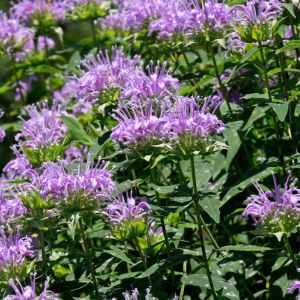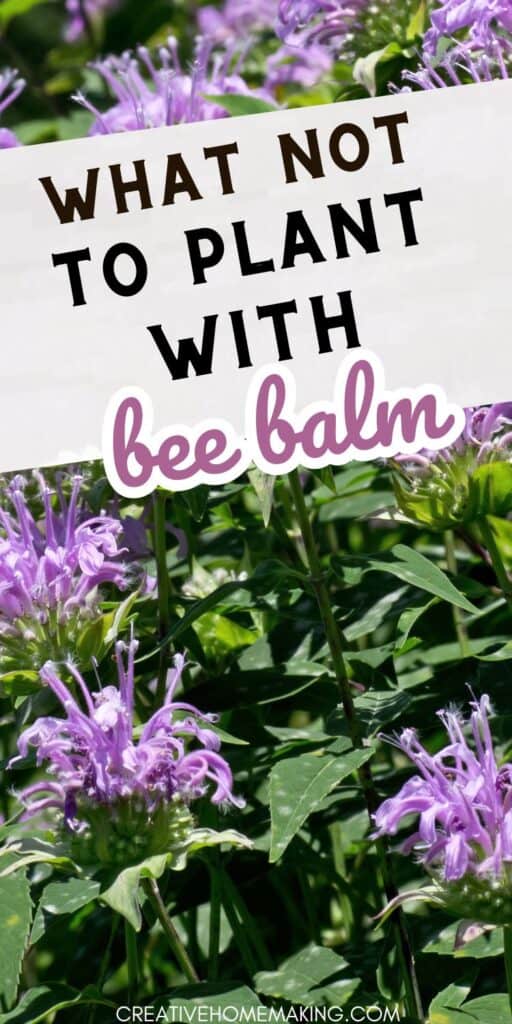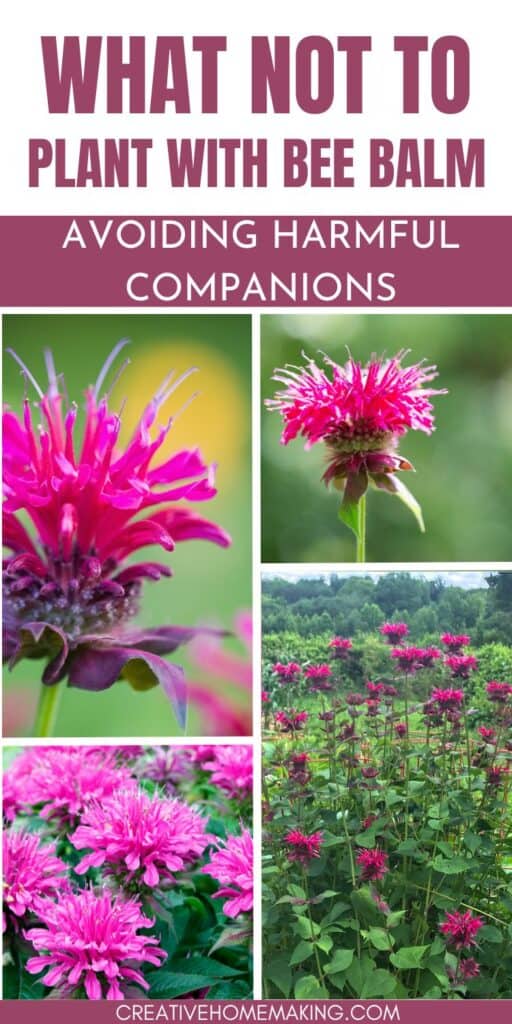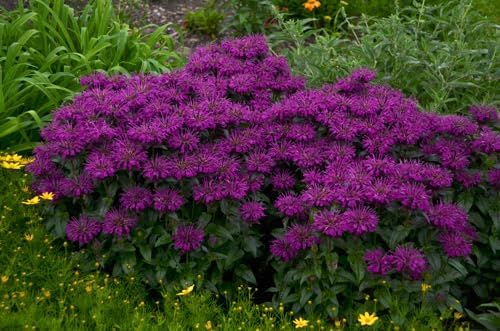Bee balm, or Monarda, is a popular perennial plant that attracts pollinators like bees, butterflies, and hummingbirds. As you plan your garden, it’s essential to consider companion planting carefully. This ensures that you create a harmonious environment where your plants can thrive.
This post may contain affiliate links.
However, not all plants play well together. In the case of bee balm, there are specific plants to avoid placing nearby. To achieve the best outcome for your garden, it’s wise to know which plants might not make the most suitable neighbors for your bee balm and why their close proximity may cause issues.
Related Article: Bee Balm, A Beautiful and Useful Plant for your Garden
Understanding Bee Balm
Bee balm, also known as monarda, bergamot, or Oswego tea, is a wonderful addition to your garden. Belonging to the botanical family Lamiaceae, there are several species of monarda, with the most common ones being Monarda didyma and Monarda fistulosa.
They are known for their vibrant, showy flowers and ability to attract pollinators like bees, butterflies, and hummingbirds.
Related Article: Growing Lemon Balm in Pots
When planting bee balm in your garden, you should be aware of its cultural requirements and companion plants. Bee balm prefers well-draining soil and plenty of sunlight. It can grow in partial shade, but a good amount of sun ensures healthier growth and more vibrant blooms.
Considering companion plants, it’s crucial to choose plants that won’t harm or compete with your bee balm. Keep in mind that bee balm might be susceptible to powdery mildew, so it’s essential to provide good air circulation and keep its surrounding area free from plants prone to spreading this disease.
When selecting companion plants for bee balm, consider factors such as sunlight, water, and nutrient requirements.
This ensures that all the plants in your garden will thrive together, creating a harmonious and vibrant space that will not only benefit you but also the local wildlife and pollinators that visit your garden.
Related Article: Growing Coneflowers from Seed: A Beginner’s Guide
Related Article: Lemon Balm a Fragrant Garden Herb
Best Conditions for Growing Bee Balm
Ideal Sunlight Requirements
When planting bee balm in your garden, make sure to give it the optimal amount of sun. This plant thrives in full sun, but it can also tolerate partial shade.
Aim to provide at least 6 hours of direct sunlight per day. If you are in an area with intense, hot sun, consider providing some afternoon shade to protect your bee balm from the heat.
Soil Preferences
Bee balm prefers fertile, well-drained soil that is rich in organic matter. You can improve your garden’s soil by regularly applying compost, which will help increase the soil’s fertility and nutrient content.
The ideal pH level for bee balm is between 6.0 and 7.0. Occasionally, you might want to add a balanced, all-purpose fertilizer to encourage healthy growth. You can check the pH of your soil with an inexpensive pH soil tester.
Watering Needs
Proper watering is essential for bee balm to grow and thrive. Make sure to keep the soil evenly moist throughout the growing season. Avoid letting the soil dry out, as this can cause stress to the plant.
During particularly hot and dry periods, you may need to water your bee balm more frequently. Remember to water deeply, so the water reaches the plant’s root system.
Related Article: What to Plant with Hydrangeas
Climate and Zone Suitability
Bee balm is a versatile plant that can grow in various climates and zones throughout North America. It thrives in USDA hardiness zones 4-9, making it suitable for a wide range of gardeners.
It typically grows to a height of 2-4 feet, so plan accordingly when selecting a location in your garden. Although bee balm can be grown in spring, summer, and fall, it is best planted during the early spring for optimal success.
Bee Balm Varieties
Bee balm, also known as Monarda, is a beautiful and versatile plant that comes in various flower colors and cultivars. As you’re interested in learning more about this plant, here’s a friendly introduction to a few popular bee balm varieties for your garden.
Purple Bee Balm is an eye-catching variety that produces vibrant purple flowers. This cultivar is attractive to pollinators, making it an excellent choice if you want to support your local bee and butterfly populations.
Greenwood Nursery/Live Perennial Plants – Bee Balm Grape Gumball + Monarda Didyma
Related Article: What to Plant in October: A Guide to Fall Gardening
Red Bee Balm or Jacob Cline is another striking option for your garden. It has vibrant red blooms and is also known for its resistance to powdery mildew, making it a low-maintenance choice that adds a pop of color to your landscape.
3 Bee Balm Gardenview Scarlet Plants in 3 Separate 4 inch containers
Pink Bee Balm varieties offer a more delicate touch to your garden with their soft pink blooms. One popular option is the Raspberry Wine cultivar, known for its large flowers and dark foliage. By including pink bee balm in your garden, you create a lovely and inviting space for pollinators.
Monarda ‘Balmy Pink’,Pink Bee Balm Seed,Bergamot 100 Seeds Perennial Flowering Plant
Related Article: What Plants Benefit from Baking Soda?
White Bee Balm cultivars are perfect for those who want a more neutral color palette in their garden. Their crisp, white flowers create a fresh and clean appearance, blending well with other plants in your landscape.
When you’re choosing bee balm varieties for your garden, consider the various flower colors and cultivars available.
By incorporating a mix of purple, red, pink, and white bee balm, you not only create a visually appealing space, but also support a healthy ecosystem for pollinators. Enjoy the process of selecting the perfect bee balm varieties for your unique garden!
Bee Balm Care
Pest and Disease Control
With proper care, you can prevent most pests and diseases from affecting your bee balm plants. To avoid powdery mildew, a common fungal disease, make sure to space your plants to allow for good air circulation. You can also use organic or chemical fungicides, but prevention is the best approach.
Pests like aphids and spider mites can be controlled with insecticidal soaps or by introducing beneficial insects, such as ladybugs, to your garden. Keep an eye on your plants and act quickly when you spot signs of infestation.
Related Article: How to Grow Lavender from Cuttings
Pruning and Deadheading
Regular pruning and deadheading will help keep your bee balm plants healthy and attractive. After the bloom time, remove spent flowers by deadheading. This practice not only keeps your plants looking tidy but also encourages more blooms.
Prune your bee balm plants in the spring or fall to control their spread, as they can become invasive. Remove any dead or damaged stems to maintain a healthy and manageable ornamental display.
Propagation Technique
Propagating bee balm is a simple way to multiply your plants or share them with friends. You can propagate bee balm by dividing their root system, taking stem cuttings, or collecting seeds.
- Dividing: In spring or fall, dig up a mature clump and gently separate it, making sure each division has a good amount of roots. Replant the divisions in your garden, spacing them to allow for growth.
- Stem cuttings: Take 4-6 inch long cuttings from healthy stems and remove the leaves from the lower half. Place the cuttings in a rooting medium and keep them moist until they develop roots.
- Seeds: Collect the seeds from your bee balm plants in late summer or early fall. Store them in a cool, dry place and sow them in early spring.
Remember to mulch around your new plants to help conserve soil moisture and suppress weed growth. A well-cared-for bee balm plant can be a beautiful and beneficial addition to your garden!
Related Article: How to Make Tea Bags
Benefits of Planting Bee Balm
Bee balm, a wonderful perennial in your garden, offers numerous benefits. Discover the advantages it provides for wildlife, culinary uses, and aesthetic value.
Attracting Wildlife
Bee balm is a nectar-rich plant that attracts various pollinators, making your garden a haven for wildlife. Its vibrant flowers lure bees, butterflies, and hummingbirds, promoting pollination and supporting local ecosystems.
By planting bee balm, you contribute to a thriving pollinator garden, helping beneficial insects and birds flourish in your area.
Culinary Uses
Bee balm is not just appealing to pollinators; it’s also an aromatic herb with various culinary uses. Its leaves make a delightful tea that can be enjoyed either hot or cold.
Bee balm, a member of the mint family, adds a unique hint of flavor to salads, teas, and other dishes. Incorporating this versatile herb in your garden allows you to enjoy its flavors and health benefits at your leisure.
Related Article: How to Prune Basil
Aesthetic Value
Aesthetically, bee balm adds a splash of color to your landscape. Its distinctive perennial flowers can range from vibrant reds, pinks, purples, and even lavender hues.
Moreover, bee balm complements other plants, creating a visually pleasing and well-rounded garden. So, not only is bee balm beneficial for wildlife and culinary uses, it also enhances the beauty of your outdoor space.
Unsuitable Neighbors for Bee Balm
While bee balm is a lovely addition to your garden, it’s essential to consider which plants should not be its neighbors. In general, there are a few plants that can negatively affect bee balm’s growth and overall health.
First, avoid planting mint or other members of the mint family near bee balm. Both plants are prone to similar pests and diseases, which can quickly spread between them. By keeping these two plants apart, you’ll minimize the chances of a problem affecting your whole mint-family plant collection.
As for companion plants, it’s best to steer clear of coneflowers, peppers, tomatoes, and daisies. The main reason is that these plants have different moisture requirements than bee balm. Otherwise, the differing water needs could lead to either plant suffering from over- or underwatering.
Furthermore, tall plants should not be placed too close to bee balm. Bee balm thrives in full sun, and taller plants may cast unwanted shadows, limiting bee balm’s access to sunlight and potentially affecting its growth.
Frequently Asked Questions
What are the best companion plants for bee balm?
Bee balm thrives when planted with other flowers such as echinacea, phlox, and yarrow, as well as with certain vegetables like tomatoes and peppers. These companions provide benefits like attracting pollinators, repelling pests, and improving the overall health of the garden.
Which vegetables should be avoided near bee balm?
Avoid planting bee balm near vegetables such as cabbage, broccoli, and other members of the brassica family, as they might attract pests that could harm both plants. It’s also a good idea to keep radishes and onions at a distance to avoid any negative interactions.
Can bee balm coexist with herbs?
Yes, bee balm can coexist with many herbs such as basil, mint, oregano, and sage, creating a beautiful and productive garden. These herbs can also help attract beneficial insects and deter pests.
Do certain plants hinder bee balm growth?
Plants like walnut trees may negatively affect bee balm due to their allelopathic properties, which can inhibit growth and cause stress to the plant. Ensure adequate spacing and avoid planting bee balm near allelopathic plants.
What to consider when planting bee balm?
When planting bee balm, choose a well-drained and sunlit area of your garden. Provide ample space between plants to promote air circulation, which helps prevent diseases like mildew. It’s also helpful to use organic compost or other soil amendments to improve soil fertility.
Are there known plant conflicts with bee balm?
Apart from the mentioned vegetables and allelopathic plants, there are no known plant conflicts with bee balm. It’s important to maintain good garden practices, provide adequate space between plants, and monitor for pests and diseases for a healthy and thriving bee balm garden.







